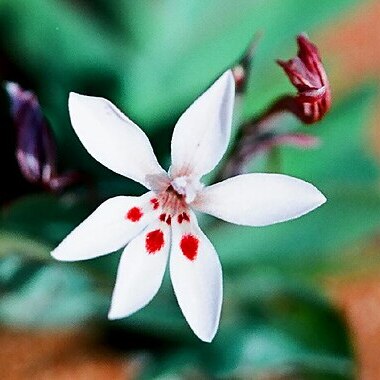Plants 100-120(-150) mm high, often ± tufted. Corm bell-shaped, 35-55 mm below ground, ± 6 mm diam.; tunics red-brown, smooth, basal rim lightly serrated, teeth directed downward. Stem usually branched, mainly at base, compressed and 2-angled, angles often weakly winged and slightly serrated, normally without cormlets at below ground nodes. Leaves 3 to 6(-many), lowermost usually conspicuously longer than others, linear, ascending to falcate, 2-3 mm wide, strongly ribbed, upper cauline leaves shorter, usually resembling bracts and not or barely ribbed, usually subtending branches. Inflorescences 2-to 6-flowered spikes, lax or crowded; outer bracts green, leaf-like, 15-25 mm long, lanceolate, acute, keeled throughout or at least distally, unifacial apically for 3-5 mm, keels often red, minutely serrated, margins hyaline, inner bract transparent with two green keels, 1/2-2/3 as long as outer, forked at tip. Flower zygomorphic, cream-coloured to beige-pink, lower tepals each with red mark near base; perianth tube 15-25(-33) mm long, cylindric, curving slightly outward at apex; tepals subequal or dorsal slightly larger, lanceolate and acute or obtuse, 8-11 x 3-4 mm, usually spreading ± horizontally when fully open, all in same plane. Stamens unilateral, erect; filaments ± 7 mm long, exserted ± 3.5 mm from tube; anthers contiguous, 1.5-2.5 mm long, violet; pollen mauve. Style dividing opposite upper half of anthers; style branches ± 1.5 mm long, divided for ± half their length. Capsules oblong, (8-)10-12 x ± 6 mm, apices of locules forming auriculate lobes decurrent on wing-like locular ridges in upper half. Seeds globose, flattened at chalazal end, ± 1.4 mm diam., dark shiny brown.
More
More-or-less tufted, cormous geophyte, 80-100 mm tall, branching at base, corm tunics brown, margins with minute, down-pointed teeth, stem compressed. Leaves linear, ribbed. Flowers in a dense, few-flowered spike, whitish with red markings on the lower tepals, brownish on the outside, perianth tube cylindrical, bracts large, with red, minutely serrate keels.

